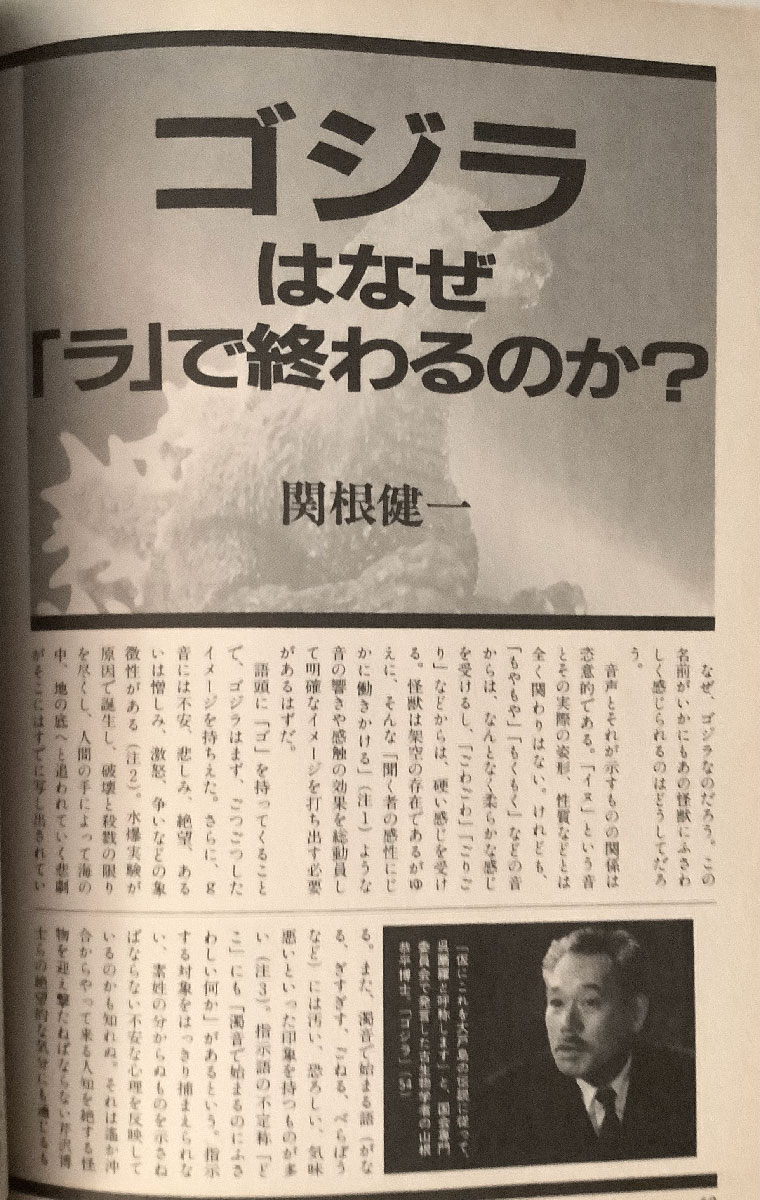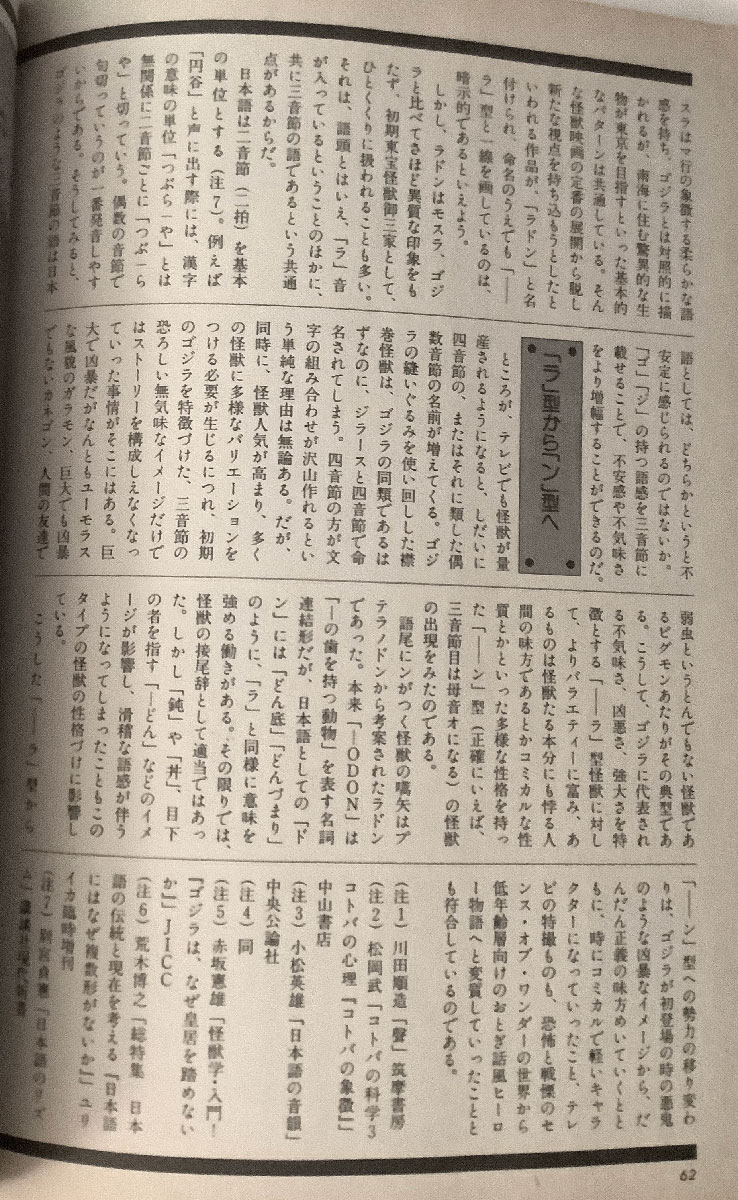4.26.2023
Why does Gojira end with “ra”?

P 60
ゴジラはんせ「ラ」で終わるのか?
Why does Gojira end with “ra”?
関根健一
Kenichi Sekine
なぜ、ゴジラなのだろう。この名前がいかにもあの怪獣にふさわしく感じられるのはどうしてだろう。
Why is it Gojira? Why does this name feel so fitting for that monster?
音声とそれが示すものの関係は恣意的である。「イヌ」という音その実際の姿形、性質などとは全く関わりはない。けれども、「もやもや」「もくもく」などの音からは、なんとなく柔らかな感じを受けるし、「ごわごわ」「ごりごり」などからは、硬い感じを受ける。怪獣は架空の存在であるがゆえに、そんな「聞く者の感性にじかに働きかける」(注1)ような音の響きや感触の効果を総動員して明確なイメージを打ち出す必要があるはずだ。
The relationship between speech and what it represents is arbitrary. The sound “dog” [inu] has nothing to do with its actual shape or nature. However, sounds such as “moyamoya” and “mokumoku” give a somewhat soft feeling, while sounds like “gowa-gowa” and “gori-gori” give a hard feeling. Monsters are fictitious creatures, so it is necessary to create a clear image by mobilizing all the effects of sounds and touches that “directly affect the listener’s sensibility” (Note 1).
「語頭に「ゴ」を持ってくることで、ゴジラはまず、ごつごつしたイメージを持ちえた。さらに、g音には不安、悲しみ、絶望、あるいは憎しみ、激怒、争いなどの象徴性がある(注2)。水爆実験が原因で誕生し、破壊と殺戮の限りを尽くし、人間の手によって海の中、地の底へと追われていく悲劇がそこにはすでに写し出されている。また、濁音で始まる語がなる、ぎすぎす、ごねる、べらぼうなど)には汚い、恐ろしい、気味悪いといった印象を持つものが多い(注3)。指示語の不定称「どこ」にも「濁音で始まるのにふさわしい何か」があるという。指示する対象をはっきり捕まえられない、素姓の分からぬものを示さねばならない不安な心理を反映しているのかも知れぬ。それは遙か沖合からやって来る人知を絶する怪物を迎え撃たねばならない芹沢博士らの絶望的な気分にも通じるものだ。
“By bringing ‘Go’ to the beginning of the word, Godzilla was able to have a rugged image. Furthermore, the g sound has a symbolism of anxiety, sadness, despair, or hatred, rage, and conflict (Note 2). The tragedy of being born as a result of a hydrogen bomb test, doing all it can to destroy and kill, and being chased to the bottom of the sea and the earth by human hands is already reflected there. In addition, many words that start with voiced sounds, such as gisugisu, goneru, and berabo, give the impression of being dirty, frightening, and creepy (Note 3). It is said that there is “something suitable to start with a voiced sound” in the indefinite noun “where” of the demonstrative word. It may reflect the uneasy psychology of not being able to clearly grasp the object to be pointed, and having to show something whose identity is unknown. It is also related to the desperate feeling of Dr. Serizawa and others who have to meet the unfathomable monster coming from far offshore.
Caption
「仮にこれを大戸島の伝説に従って、呉爾羅と呼称します」と、国会専門委員会で発言した古生物学者の山根恭平博士。「ゴジラ」(54)
“I will tentatively call it GOJIRA, following the legend of Odo Island,” said paleontologist Dr. Kyohei Yamane, speaking at a Diet committee. “Godzilla” (1954)

P 61
ゴジラに対抗する新手の怪獣バトラは、BATTLEにちなむが、そんな外国語の意味とは切り離しても、いかにも悪役らしく響くのはやはり語頭の濁音が効いているからだ。
The new monster Battra, which competes against Godzilla, is named after BATTLE, but even if you separate it from the meaning of such a foreign word, it sounds like a villain because of the voiced sound at the beginning of the word.
元来、語頭に濁音がそれも連続してくるというのは日本語にはきわめて少なく、エキゾチックで非日常的な雰囲気を醸し出す。加えて、「いじる」「やじる」「ほじる」「ねじまげる」など、「じる」という形の動詞は、「いやらしい動作、行為の表現」(注4)が多い。「ごじら」というのは、ごつごつしてなにか得体の知れない存在の行ういやらしい行為を表す動詞の未然形とでもいおうか。
Originally, it is very rare in Japanese to have a continuous voiced sound at the beginning of a word, creating an exotic and extraordinary atmosphere. In addition, many verbs in the form of “jiru,” such as “twisting,” “yajiru,” “hojiru,” and “nejimageru,” are “expressions of obscene actions” (Note 4). “Gojira” may be said to be the unborn form of a verb that expresses an obscene act performed by some kind of rugged, mysterious entity.
ところで、音声の象徴性には、こうした感覚に直接訴えてくる原初的とでもいう感じ方のほかに、ある名前を連想させる音を入れることでその属性の一部を与えるという場合がある。「悪魔くん」に登場する妖怪ペロリゴンは、あっという間に食べてしまう様を表す「ぺろりと」という副詞からの連想で、その形態、性質はたやすく推量できる。そもそもゴジラはゴリラとクジラをくっつけた名で、その力強さ、巨大さなどを合わせ持たせる意味があったとも聞く。しかし、ゴジラという名前が圧倒的な存在感をもって自立している今ではそんな連想にひかれることはないし、スクリーンに初登場し当時でも、「ゴ」「ジ」の語感の強烈さの前では、実在の動物のイメージはかき消されてしまったのではないか。むしろ逆に、それ以後、ゴジラは、後進の怪獣たちの多くに自己のイメージを与え続けてきた。怪獣だけではない。例えば、ストーリーの残酷さで話題になった、ジョージ秋山の「アシュラ」は、その名はむろんゴジラよりはるか以前に存在してはいたが、その実態とは無関係に、読み手は無意識にゴジラを連想することで、あの漫画の怪奇性をその名前から先取り、ないしは補完することがてきた。あの時点で、すでにゴジラ自身があるなにか共通の「感じ」を与えることのできる象徴的音声となっていたのである。
By the way, in the symbolism of sound, in addition to the primordial feeling that directly appeals to the senses, there are cases where a part of the attribute is given by inserting a sound that is associated with a certain name. The yokai pelorigon that appears in “Akuma-kun” is associated with the adverb “perorito,” which means that it eats up quickly, and its form and nature can be easily guessed. Originally, Godzilla was a combination of gorilla and whale, and it is said that it was meant to have both strength and giganticness. However, now that the name Godzilla has an overwhelming presence and stands on its own, I am no longer drawn to such associations. It seems that the image of real animals has been erased. On the contrary, since then, Godzilla has continued to give his image to many backward monsters. Not just monsters. For example, George Akiyama’s “Asura,” which became a hot topic due to the cruelty of its story, of course existed long before Godzilla, but regardless of its reality, readers unconsciously associate it with Godzilla. By doing so, I have been able to anticipate or complement the weirdness of that manga from its name. At that point, Godzilla himself had already become a symbolic voice that could give a certain common “feel.”
Akuma-kun is a manga series written and illustrated by Shigeru Mizuki. Several versions of the manga exist, one of which was adapted into a live-action TV show, and another into an anime television series. (Source: Wikipedia https://en.wikipedia.org/wiki/Akuma-kun)
注意したいのは、私たちがゴジラを連想できるのは、最後に「ラ」が来る名前に限られるということだ。たとえば、ゴアゴンゴン(マグマ大使)、ゴーガ(ウルトラQ)、ラジゴン(キャプテンウルトラ)などの名から、ゴジラを思い起こすことはない。
It should be noted that we can only associate Godzilla with names ending in “ra.” For example, names such as Goagongon (Ambassador Magma), Gorga (Ultra Q), and Rajigon (Captain Ultra) do not remind us of Godzilla.
ラ音と三音節の秘密
The secret of ra sounds and trisyllables
では、「ラ」とはなにか。ゴジラは例の祝詞には「呉爾羅」と表記されているという。「羅」は「曼陀羅」「伽羅」など、サンスクリットの当て字に使われることもあり、異国的な秘密めいた香りを感じさせる。また、恣意的な選択というそしりは免れないかもしれないが、ラの語尾の和語の中から、何物かが潜んでいるかもしれぬ「裏」、どこからか何かが流れ着く「浦」、果てしのない「空」、異国の代名詞であった「唐」など、日常を離れ、空想の世界に遊ぶには格好の用語を拾いだすことはたやすい。ユダヤ教のカバラに、その内容は知らず、なんとなく神秘的な印象を抱いてしまうのも、そんな語彙のイメージが心理の深層に穿たれているからだろう。
So what is “ra”? It is said that Godzilla is written as “GOJIRA” in the example of the Norito. “Ra” is sometimes used in Sanskrit phonetic equivalents such as “mandala” and “kyara,” and it has an exotic and secret scent.
Also, although it may be unavoidable to say that it is an arbitrary choice, from the Japanese words at the end of the word ra, there may be something hidden behind (ura), It’s easy to pick up terms that are perfect for leaving the everyday world behind and playing in a fantasy world, such as the endless “sora (sky)” and the pronoun “kara” that used to be synonymous with foreign lands. I don’t know the content of Jewish Kabbalah, and somehow I have a mysterious impression because the image of such vocabulary is pierced deep in my psyche.
こうして「ラ」の正体を求めて国語の森の中を渉猟していると、それは「ぼくら」「それら」「子供ら」など、複数を表す接尾辞でもあることに気づく。ゴジラは複数形なのである。そういえば、ゴジラに南方で戦死した兵士の数知れぬ霊魂の群れを見る解釈もあった(注5)。不可思議な想像を絶する何ものかが集合し、固まったもの。そう、ゴジラをはじめ怪獣たちは群れを成すことはない。一匹でそのまま群れであるのだから。
As I traverse the forest of Japanese language in search of the identity of “ra,” I realize that it is also a suffix that expresses the plural, such as “bokura (we),” “sorera (those),” and “kodomo-ra (children).” Godzilla is plural. Come to think of it, there was also an interpretation that Godzilla sees an innumerable group of souls of soldiers who died in battle in the south (Note 5). Something mysterious and unimaginable gathered and solidified. Yes, monsters, including Godzilla, do not form herds. Because one animal is a herd.
「ら」には、「きよら」が美一般を「指す「きよげ」よりも一段上の美しさを表すように、「語幹の性質が一層増幅したもの、広がったものであることを示す役割」があるともいう(注6)。「ゴジ」がもたらす性質をいっそう強め、強調するのが「ラ」なのだ。強意形とでもいおうか。怪獣の接尾辞としてまことにふさわしいではないか。「ゴジ」はゴジラ自身の個性を、「ラ」は彼により創始された怪獣族全体の属性を表すのである。
“Ra” expresses beauty on a higher level than “Kiyoge,” which refers to general beauty in “Kiyora.” It is also said that there is a role (Note 6). It is “ra” that reinforces and emphasizes the qualities that “goji” brings. You could call it the intensive form. Isn’t it really suitable as a suffix for monsters? “Goji” represents Godzilla’s own individuality, and “Ra” represents the attributes of the monster tribe founded by him.

P 62
モスラはマ行の象徴する柔らかな語感を持ち、ゴジラとは対照的に描かれるが、南海に住む驚異的な生物が東京を目指すといった基本的なパターンは共通している。そん怪獣映画の定番の展開から脱し新たな視点を持ち込もうとしたといわれる作品が、「ラドン」と名付けられ、命名のうえでも「―ラ」型と一線を画しているのは、暗示的であるといえよう。
Mothra has a soft sense of language that symbolizes “ma” line [in the Japanese syllabary table], and is drawn in contrast to Godzilla, but the basic pattern of the amazing creature living in the southern seas heading for Tokyo is common. The movie, which is said to have broken away from the standard development of monster movies and tried to bring in a new perspective, was named “Rodan,” and it is implied that the naming also distinguishes it draws a line from the “-ra” type in terms of naming.
しかし、ラドンはモスラ、ゴジラと比べてさほど異質な印象をもたず、初期東宝怪獣御三家として、ひとくくりに扱われることも多い。それは、語頭とはいえ、「ラ」音が入っているということのほかに、共に三音節語であるという共通点があるからだ。
However, Rodan doesn’t give the impression of being so different from Mothra and Godzilla, and is often treated as one of the three early Toho monsters. This is because, although it is the beginning of a word, it has the sound “ra” in it, and also because they are three-syllabic words in common.
日本語は二音節(二拍)を基本の単位とする(注7)。例えば「円谷」と声に出す際には、漢字の意味の単位「つぶらーや」とは無関係に二音節ごとに「つぶーら「や」と切っていう。偶数の音節で切っていうのが一番発音しやすいからである。そうしてみると、ゴジラのような三音節の語は日本語としては、どちらかというと不安定に感じられるのではないか。「ゴ」「ジ」の持つ語感を三音節に載せることで、不安感や不気味さより増幅することができるのだ。
Japanese uses two syllables (two beats) as a basic unit (Note 7). For example, when saying “Tsuraya” out loud, “Tsubura ya” is cut every two syllables regardless of the kanji unit “Tsuburaya.” This is because it is easiest to pronounce when it is cut at an even number of syllables. When you think about it, it seems that three-syllable words like GOJIRA are rather unstable in Japanese. By putting the word feeling of “go” and “ji” on three syllables, it is possible to amplify the sense of uneasiness and eeriness.
「ラ」型から「ン」型へ
From “ra” type to “n” type
ところが、テレビでも怪獣が量産されるようになると、しだいに四音節の、またはそれに類した偶数音節の名前が増えてくる。ゴジラの縫いぐるみを使い回しした襟巻怪獣は、ゴジラの同類であるはずなのに、ジラースと四音節で命名されてしまう。四音節の方が文字の組み合わせが沢山作れるという単純な理由は無論ある。だが、同時に、怪獣人気が高まり、多くの怪獣に多様なバリエーションをつける必要が生じるにつれ、初期のゴジラを特徴づけた、三音節の恐ろしい無気味なイメージだけではストーリーを構成しえなくなっていった事情がそこにはある。巨大凶暴だがなんともユーモラスな風貌のガラモン、巨大でも凶暴でもないカネゴン、人間の友達で弱虫というとんでもない怪獣であピグモンあたりがその典型である。こうして、ゴジラに代表される不気味さ、凶悪さ、強大さを特に。徴とする「――ラ」型怪獣に対して、よりバラエティーに富み、あるものは怪獣たる本分にも悖る人間の味方であるとかコミカルな性質とかといった多様な性格を持った「ン」型(正確にいえば、偶三音節目は母音オになる)の怪獣シの出現をみたのである。
However, as monsters began to be mass-produced on TV, the number of even-numbered syllable names, such as those with four syllables, gradually increased. A collared monster that reuses Godzilla’s suit is supposed to be of the same kind as Godzilla, but it is named with four syllables as Jirasu. There is, of course, a simple reason why four syllables make more letter combinations. However, at the same time, as the popularity of kaiju increased, and the need to create a variety of variations for many kaiju, it became impossible to compose a story with only the three syllables and the creepy image that characterized the early Godzilla. Typical examples are Garamon, which has a gigantic ferocity but a humorous appearance, Kanegon, which is neither gigantic nor ferocious, and Pigmon, a ridiculous monster that is a friend of humans and a coward. In this way, especially the spookiness, brutality, and mightiness represented by Godzilla. In contrast to the typical “—ra” type monsters, there are more variety, I saw the emergence of “—n” type monsters with diverse personalities, such as being friendly to humans and having a comical nature, some of which defy their duty as monsters. (To be precise, the even third syllable becomes the vowel o).
語尾にンがつく怪獣の嚆矢はプテラノドンから考案されたラドンであった。本来「IODON」は「一の歯を持つ動物」を表す名詞連結形だが、日本語としての「ドン」には「どん底」「どんづまり」のように、「ラ」と同様に意味を強める働きがある。その限りでは、怪獣の接尾辞として適当ではあった。しかし「鈍」や「丼」、目下の者を指す「どん」などのイメージが影響し、滑稽な語感が伴うようになってしまったこともこのタイプの怪獣の性格づけに影響している。
The origin of the monsters with the ending of the word was Rodan, which was invented from Pteranodon. Originally, “IODON” is a noun concatenated form that means “animal with one tooth,” but in Japanese, “don” has the same meaning as “ra,” such as “don bottom” and “donzumari (end of the line).”
As far as that goes, it was an appropriate suffix for monsters. However, the image of “don (dull),” “donburi (sloppy),” and “don,” which refers to a lower-ranking person, has influenced the characterization of this type of kaiju, resulting in a humorous sense of language.
こうした「ラ」型から「——ン」型への勢力の移り変わりは、ゴジラが初登場の時の悪鬼のような凶暴なイメージから、だんだん正義の味方めいていくとともに、時にコミカルで軽いキャラクターになっていったこと、テレビの特撮ものも、恐怖と戦慄のセンス・オブ・ワンダーの世界から低年齢層向けのおとぎ話風ヒーロ物語へと変質していったこととも符合しているのである。
This shift in power from the “ra” type to the “—n” type is that when Godzilla first appeared, it was a ferocious image like a demon, but gradually he became an ally of justice, and at times he became a comical and light character. After all, it is also in line with the fact that TV special effects have changed from the world of horror and horror sense of wonder to fairy tale-like hero stories for the younger generation.
(注1) 川田順造「聲」筑摩書房
(Note 1) Junzo Kawada “Voice” Chikuma Shobo
(注2)松岡武「コトバの科学3コトバの心理『コトバの象徴』」中山書店
(Note 2) Takeshi Matsuoka “Science of Words 3 Psychology of Words ‘Symbol of Words'” Nakayama Shoten
(注3)小松英雄「日本語の音韻」中央公論社
(Note 3) Hideo Komatsu “Japanese Phonology” Chuokoronsha
(注4)同
(Note 4) Same
(注5)赤坂憲雄「怪獣学・入門!「ゴジラは、なぜ皇居を踏めないか』」JICC
(Note 5) Norio Akasaka, “Introduction to Monster Studies: Why Godzilla Can’t Step on the Imperial Palace,” JICC
(注6) 荒木博之「総特集日本語の伝統と現在を考える『日本語にはなぜ複数形がないか』」ユリイカ臨時増刊
(Note 6) Hiroyuki Araki, “Considering Japanese Traditions and the Present: Why Japanese Has No Plural Forms?”
(注7)別宮貞憲「日本語のリズム」講談社現代新書
(Note 7) Sadanori Betsumiya “Japanese Rhythm” Kodansha Gendai Shinsho
Source: ゴジラだ‼︎, p 60-62